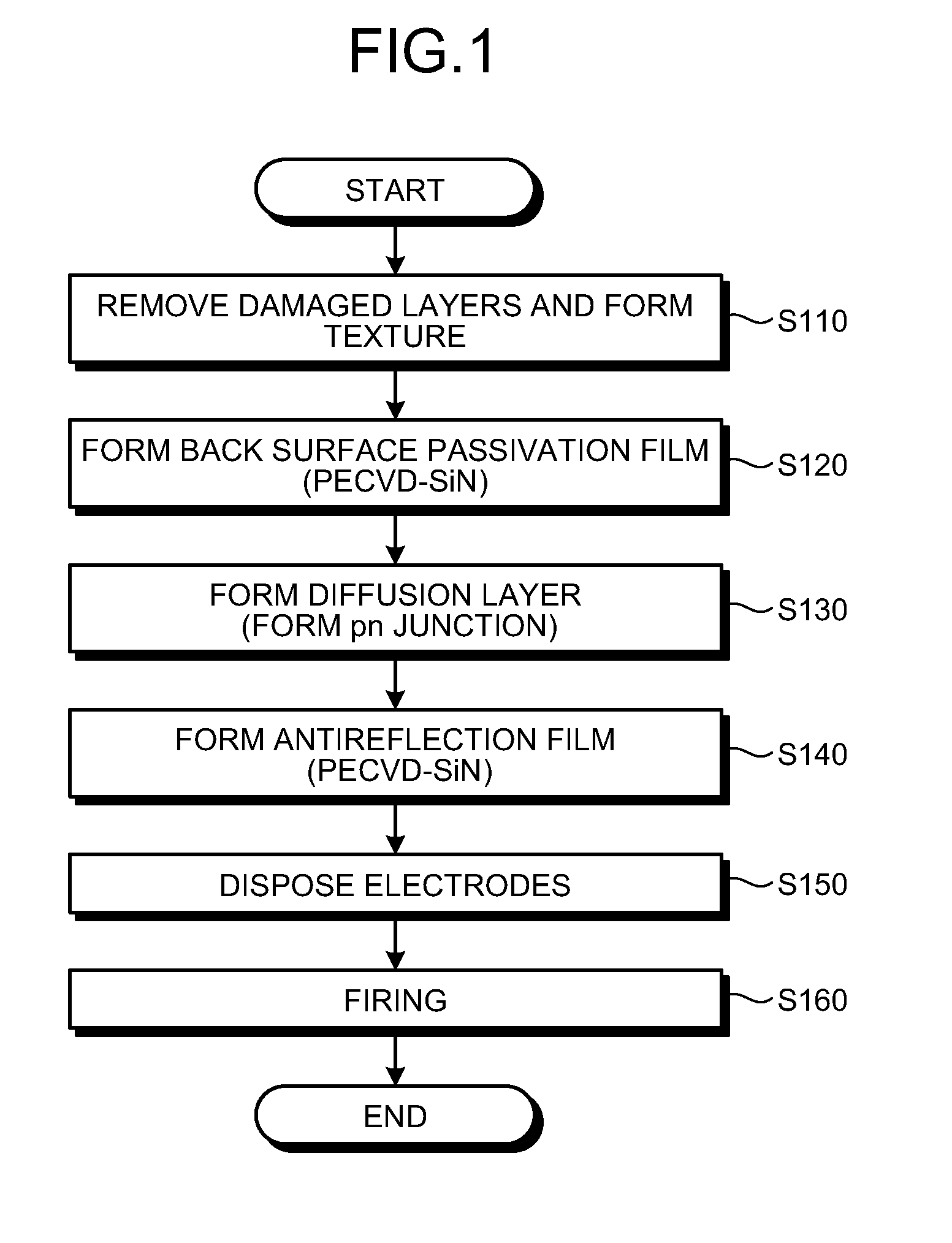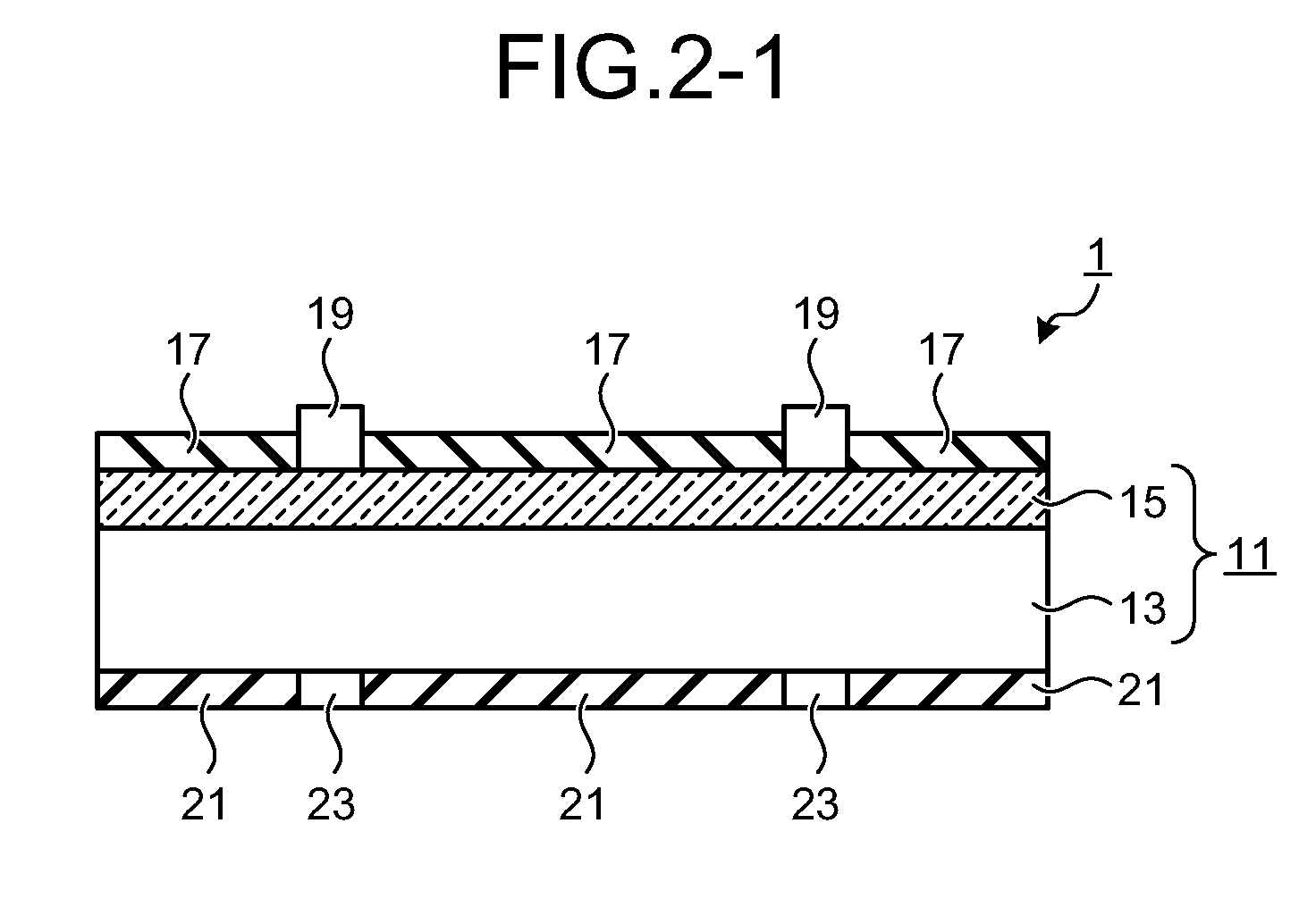Method for manufacturing solar battery cell
a solar battery and manufacturing method technology, applied in the field of manufacturing a solar battery cell, can solve the problems of increasing the thickness the shortening of silicon materials of the solar battery, and the warpage of the solar battery cell, and achieve the effect of high photoelectric conversion efficiency
- Summary
- Abstract
- Description
- Claims
- Application Information
AI Technical Summary
Benefits of technology
Problems solved by technology
Method used
Image
Examples
first embodiment
[0067]FIG. 1 is a flowchart describing the method for manufacturing a solar battery cell according to a first embodiment of the present invention. As shown in FIG. 1, the method for manufacturing a solar battery cell according to the present embodiment includes: a damaged layer removing and texture forming step (step S110); a back surface passivation film (PECVD-SiN) forming step (step S120); a diffusion layer forming (pn junction forming) step (step S130); an antireflection film (PECVD-SiN) forming step (step S140); an electrode disposing step (step S150); and a firing step (step S160).
[0068]FIGS. 2-1 to 2-3 are diagrams illustrating the schematic configuration of a solar battery cell 1 produced by the method for manufacturing a solar battery cell according to the present embodiment. FIG. 2-1 is a cross sectional view of the solar battery cell 1, FIG. 2-2 is an upper view of the solar battery cell 1, as viewed from its light receiving surface side, and FIG. 2-3 is a bottom view of ...
second embodiment
[0106]In a second embodiment, to examine the advantages of the method for manufacturing a solar battery cell according to the first embodiment, solar battery cells in Example 2 were produced using the same process as that for the solar battery cells in Example 1. The configuration of the solar battery cells in Example 2 was the same as that of the solar battery cells in Example 1, and the size of the solar battery cells was 4 cm2. Solar battery cells in Comparative Example 2 were also produced, and the output characteristics were compared. The configuration of the solar battery cells in Comparative Example 2 was the same as that of the solar battery cells in Example 2, and the size of the solar battery cells was 4 cm2, which was the same as the size of the solar battery cells in Example 2.
[0107]The solar battery cells in Comparative Example 2 were produced by a conventional process shown in FIG. 8. FIG. 8 is a flowchart describing a method for manufacturing the solar battery cells i...
third embodiment
[0120]In a third embodiment, the dependence on the properties of the PECVD-SiN film serving as the back surface passivation film was examined. For this purpose, solar battery cells in Example 3 were produced by depositing a PECVD-SiN film having a refractive index n of 2.0 on the back surface of a p-type polycrystalline silicon wafer to a thickness of 80 nm to 90 nm. In addition, solar battery cells in Example 4 were produced by depositing a PECVD-SiN film having a refractive index n of 2.2 on the back surface of a p-type polycrystalline silicon wafer to a thickness of 80 nm to 90 nm. The solar battery cells in Examples 3 and 4 were produced by the same process as that for the solar battery cells in Example 1. The structures of the solar battery cells in Examples 3 and 4 were the same as the configuration of the solar battery cells in Example 1, and the size of each battery cell was 4 cm2.
[0121]Conventional solar battery cells (Comparative Example 3) each having an Al-BSF layer disp...
PUM
| Property | Measurement | Unit |
|---|---|---|
| refractive index | aaaaa | aaaaa |
| temperature | aaaaa | aaaaa |
| thickness | aaaaa | aaaaa |
Abstract
Description
Claims
Application Information
 Login to View More
Login to View More - R&D
- Intellectual Property
- Life Sciences
- Materials
- Tech Scout
- Unparalleled Data Quality
- Higher Quality Content
- 60% Fewer Hallucinations
Browse by: Latest US Patents, China's latest patents, Technical Efficacy Thesaurus, Application Domain, Technology Topic, Popular Technical Reports.
© 2025 PatSnap. All rights reserved.Legal|Privacy policy|Modern Slavery Act Transparency Statement|Sitemap|About US| Contact US: help@patsnap.com



